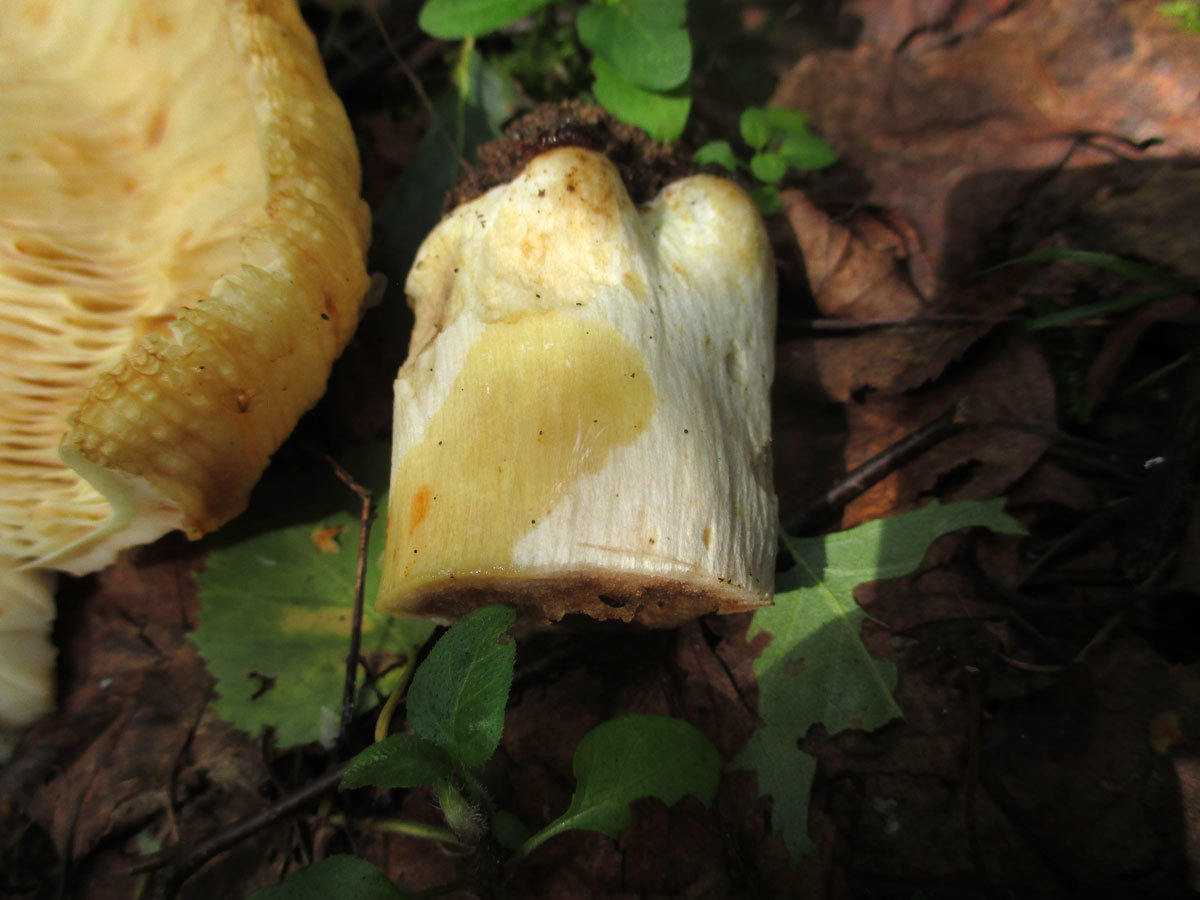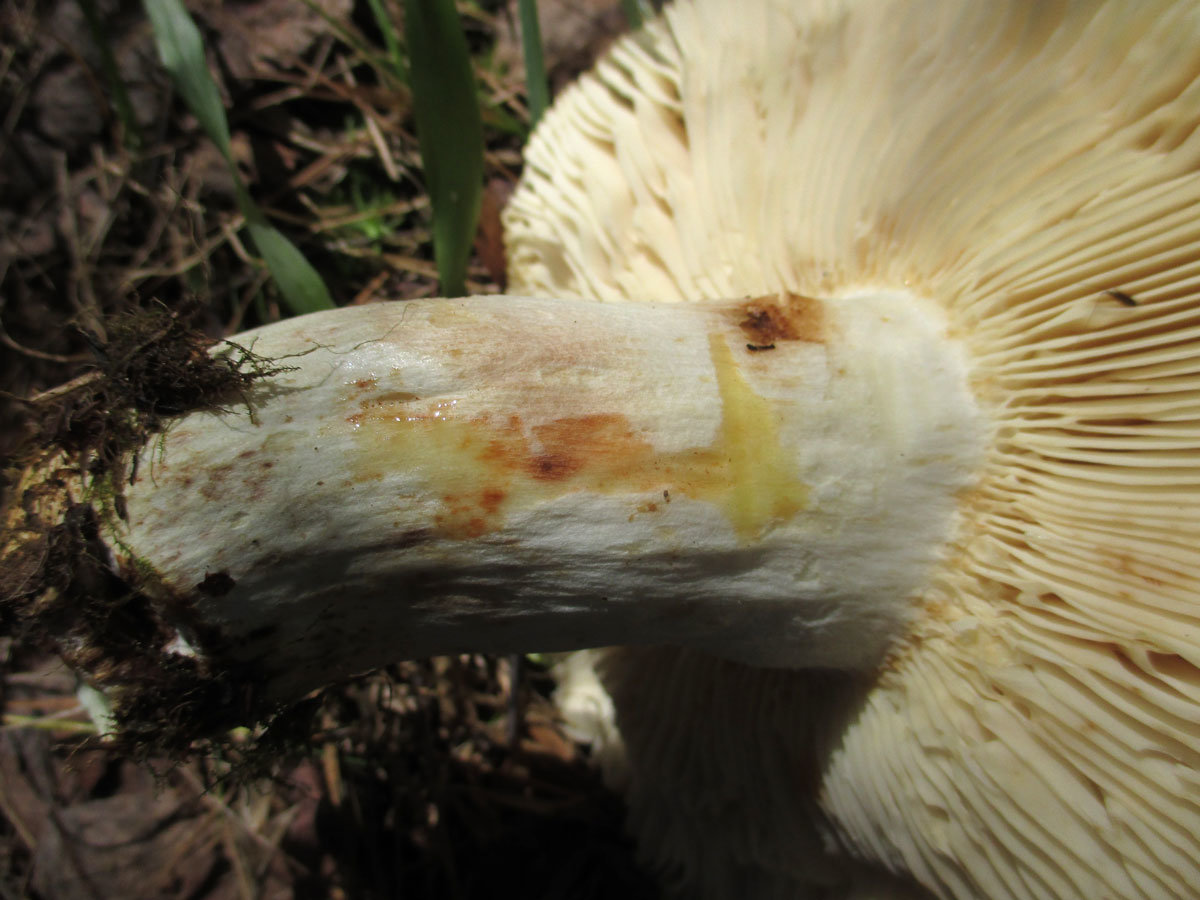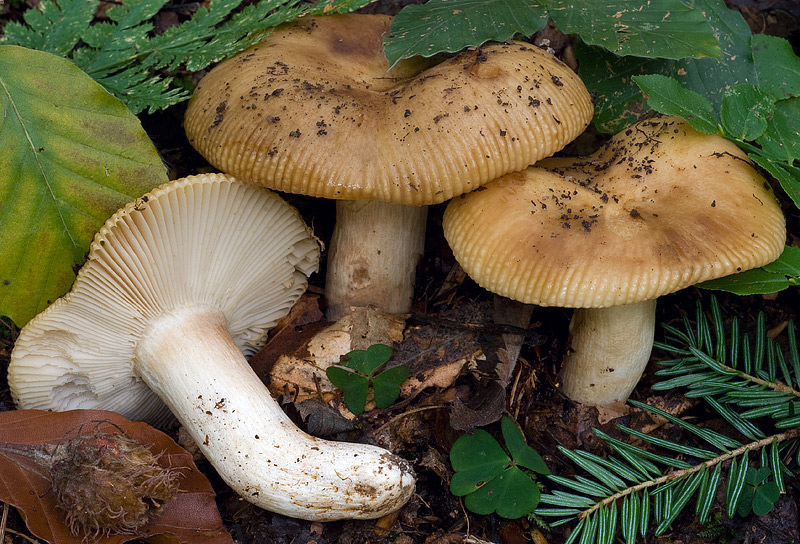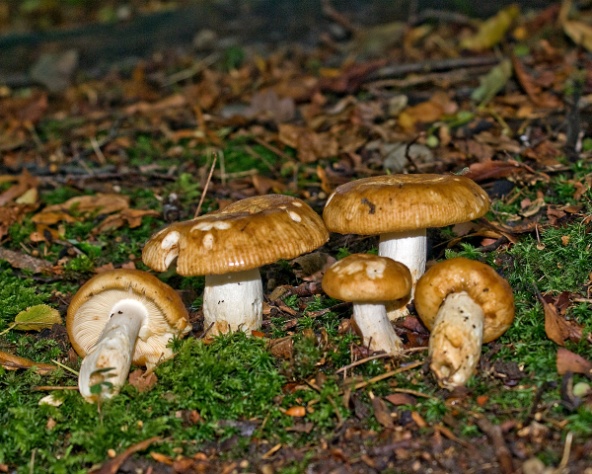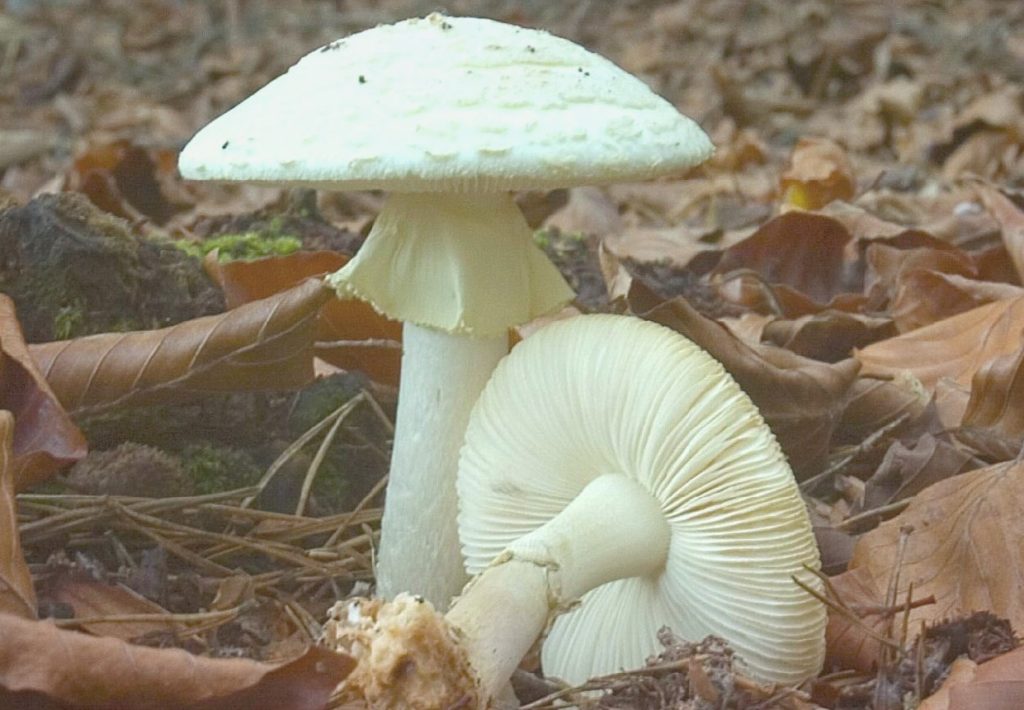Views
Main article: Species of the genus Russula
About 275 species of the genus are known Russula... About 60 species have been identified in Russia.
| Cat. * | Latin name | Russian name | ||||||||||
|---|---|---|---|---|---|---|---|---|---|---|---|---|
| Russula acetolens | Acetic russula | |||||||||||
| Russula adusta | Black podgruzdock, black russula, nigella | |||||||||||
| Russula aeruginea | Green russula, pale green russula, bluish-green russula, green herbal russula | |||||||||||
| Russula albonigra | Podgruzdok black-and-white, russula white-black, nigella white-black | |||||||||||
| Russula alutacea | Green-red russula, kidney russula, leathery russula | |||||||||||
| Russula amarissima | Bitter russula | |||||||||||
| Russula amethystina | Amethyst russula | |||||||||||
| Russula aquosa | Russula watery | |||||||||||
| Russula aurata | Golden russula, golden russula, golden russula | |||||||||||
| Russula azurea | Blue russula, azure russula | |||||||||||
| Russula badia | Cedar russula, purple-brown russula | |||||||||||
| Russula betularum | Birch russula, birch russula | |||||||||||
| Russula caerulea | Russula blue | |||||||||||
| Russula cessans | Russula deceiving | |||||||||||
| Russula chloroides | Podgruzdok greenish, chlorine-like russula | |||||||||||
| Russula claroflava | Yellow russula, light yellow russula, pale yellow russula, bright yellow russula | |||||||||||
| Russula consobrina | Related russula, gray russula, brown russula | |||||||||||
| Russula cyanoxantha | Blue-yellow russula, blue-green russula, multi-colored russula | |||||||||||
| Russula decolorans | Gray russula, fading russula | |||||||||||
| Russula delica | White podgruzdok, rusk, dry lump | |||||||||||
| Russula densifolia | Frequent plate loading | |||||||||||
| Russula emetica | Acid russula, pungent russula, emetic russula, nauseous russula | |||||||||||
| Russula faginea | Beech russula | |||||||||||
| Russula farinipes | Russula value-shaped | |||||||||||
| Russula fellea | Russula bilious | |||||||||||
| Russula foetens | Valuy, snotty, bull, cam, kulbik | |||||||||||
| Russula fuscorubroides | Russula blushing false | |||||||||||
| Russula fragilis | Russula fragile | |||||||||||
| Russula fragrantissima | Fragrant russula | |||||||||||
| Russula gracillima | Russula graceful | |||||||||||
| Russula grata | The russula is pleasant | |||||||||||
| Russula graveolens | Fetid russula | |||||||||||
| Russula grisea | Russula gray | |||||||||||
| Russula griseascens | Russula grayish | |||||||||||
| Russula heterophylla | Forked russula, multi-lamellar russula, greenish-brownish russula, green russula | |||||||||||
| Russula illota | ||||||||||||
| Russula inamoena | Russula unpleasant | |||||||||||
| Russula integra | Whole russula, wonderful russula | |||||||||||
| Russula ionochlora | Russula purple-green | |||||||||||
| Russula laurocerasi | Almond russula, cherry laurel russula | |||||||||||
| Russula lepida | Russula beautiful | |||||||||||
| Russula lilacea | Lilac russula | |||||||||||
| Russula livescens | Blue russula | |||||||||||
| Russula lutea | Russula golden-yellow, russula red-yellow | |||||||||||
| Russula maculata | Russula spotted | |||||||||||
| Russula mairei | Mayor's russula | |||||||||||
| Russula melzeri | Melzer's russula | |||||||||||
| Russula mustelina | Russula smooth-skinned | |||||||||||
| Russula nana | Russula dwarf | |||||||||||
| Russula nauseosa | Russula nondescript | |||||||||||
| Russula nigricans | Blackening podgruzdock, blackening russula | |||||||||||
| Russula nitida | Russula brilliant | |||||||||||
| Russula ochroleuca | Ochreous russula, pale ocher russula, pale yellow russula, lemon russula, ocher-yellow russula, ocher-yellow russula, ocher-white russula | |||||||||||
| Russula olivacea | Olive russula | |||||||||||
| Russula paludosa | Swamp russula, float | |||||||||||
| Russula parazurea | Russula almost azure | |||||||||||
| Russula pectinata | Russula comb | |||||||||||
| Russula pectinatoides | Rusula comb-ribbed | |||||||||||
| Russula pseudodelica | White false load | |||||||||||
| Russula pseudointegra | Rusula ruddy, russula pseudo-red, russula pseudo-intact | |||||||||||
| Russula puellaris | Girl's russula, soft russula | |||||||||||
| Russula pulchella | Fading russula, beautiful russula, beautiful russula | |||||||||||
| Russula purpurata | Russula purple | |||||||||||
| Russula queletti | Russula Kele | |||||||||||
| Russula rosea | Russula pink | |||||||||||
| Russula rubra | Russula red | |||||||||||
| Russula sanguinea | Russula blood red | |||||||||||
| Russula sardonia | Russula sardonyx, russula sharp-eating, russula bitter | |||||||||||
| Russula seperina | Various russula | |||||||||||
| Russula turci | Turkish russula | |||||||||||
| Russula undulata | Wavy russula | |||||||||||
| Russula velenovskyi | Velenovsky's russula | |||||||||||
| Russula versicolor | Russula multicolored | |||||||||||
| Russula vesca | Edible russula, edible russula, wonderful russula | |||||||||||
| Russula vinosa | Wine red russula, purple red russula | |||||||||||
| Russula violacea | Lilac russula | |||||||||||
| Russula violeipes | ||||||||||||
| Russula virescens | Greenish russula, scaly russula | |||||||||||
| Russula viscida | Glutinous russula | |||||||||||
| Russula xerampelina | Brown russula, aromatic russula, purple russula, herring russula | |||||||||||
|
Taste qualities of almond russula
These are edible mushrooms. They are pungent to taste, but have a pleasant almond aroma. They can be boiled, fried and salted.
Similarity to other mushrooms
Cherry laurel russula outwardly resembles Valui, but the latter is larger.Valuya has a burning taste, an unpleasant smell, similar to spoiled oil. Valui is also an edible representative of the mushroom kingdom, so nothing terrible will happen if you confuse these species.
Other types of russula
Pink russula or beautiful russula - conditionally edible mushroom. The caps of these mushrooms can be semi-round and flat, they are not depressed. The edges of the caps are smooth. The surface of the cap is velvety, dry; in wet weather, a small amount of mucus appears on it. The color of the cap is changeable - it varies from dark pink to red. The leg is cylindrical and regular in shape, firm and thick. The color of the leg is white, there may be a pink tint.

The russula pink are ubiquitous in Eurasia and North America. They grow in deciduous and coniferous forests. Pink russula can be found in mountainous regions. They bear fruit from July to October. The taste qualities of these mushrooms are mediocre, they have a bitter taste, so they have to be cooked for a long time.
The russula blue or azure is an edible mushroom. The diameter of her cap does not exceed 8 centimeters. The hat is fleshy. Its shape is initially convex, and then it becomes flat, depressed in the center. The peel from the cap is easily separated. The color of this russula can be dark purple or amethyst blue, sometimes it is olive blue or lilac. The center of the cap is darker and the edges are lighter. The leg is solid, no more than 5 centimeters high, white. Young russula have strong legs, and eventually become hollow.
These russula grow in coniferous forests, mainly in spruce forests. They can come across whole nests. Blue russula are common in the central and European parts of Russia, as well as in the Baltic States. They usually settle in groups. Fruiting from August to September. These are edible mushrooms, according to their taste, they are referred to the 3rd category. Blue russula can be eaten fresh and salted.

False russules
This term usually means inedible or slightly edible representatives of the genus Russula, which are easily confused with well-edible species. In the list below, you will find such types. These mushrooms, however, will not cause, in case of a mistake, serious harm to an inattentive gatherer - there are no deadly representatives of this genus on the lists. A mistaken mushroom treat or an eating disorder is a common consequence of eating inedible russula.
Inexperienced mushroom pickers, however, have a chance to confuse some species of russula - especially light-colored ones - with the main killer of the mushroom world, the Pale Toadstool Amanita Phalloides

Pale Toadstool Amanita Phalloides
Even a small piece of this mushroom can kill a person, therefore, when collecting russules, you should always remember about the Pale Toadstool and its distinctive features, the main of which are two:
- White ring - a skirt with a leg. This is a great reference point - the russules do not have a ring. The ring, however, can fall off from old age or mechanical damage, and this must also be taken into account. Usually, even when it fell off, a characteristic mark from it remains on the toadstool's leg.
- The white egg is a volva, at the base of the toadstool's leg. Russula doesn't have it either. The Volvo can also disappear over time, or be buried in the forest floor - if you suspect, this should definitely be checked.
Literature
- Garibova L.V., Sidorova I.I. Mushrooms. Encyclopedia of the Nature of Russia. - M., 1999
- Mushrooms of the USSR. - M., 1980
- Arora, D. (1986). Mushrooms demystified: A comprehensive guide to the fleshy fungi, Berkeley: Ten Speed Press. pp. 83-103
- Funghi - Instituto Geografico De Agostini, Novara, Italia, 1997
- Kibby, G. & Fatto, R. (1990). Keys to the species of Russula in northeastern North America, Somerville, NJ: Kibby-Fatto Enterprises. 70 pp
- Weber, N. S. & Smith, A. H. (1985). A field guide to southern mushrooms, Ann Arbor: U Michigan P. 280 pp
- Moser, M. (1978) Basidiomycetes II: Röhrlinge und Blätterpilze, Gustav Fischer Verlag Stuttgart. English edition: Keys to Agarics and Boleti ... published by Roger Phillips, London
- Partly translated from Dutch page
Flawless russula taste
The russula flawless is an edible mushroom. According to its taste, it was assigned the 3rd category. These mushrooms can be eaten fresh or salted.
Similar species
Whole russula can be confused with other types of russula, but they have a spicy or peppery taste. This mushroom looks like a green-red russula.
Other mushrooms of this genus
Scaly russula is an edible mushroom. The diameter of its cap is 5-15 centimeters. At first, the shape is hemispherical, but with age, a depression forms in the center, and the edges rise up. The color of the cap is green or gray-green. The edges of the cap are slightly torn, the skin is removed up to half of the cap. The leg is white, dense.
Scaly russula grow in deciduous forests, choosing areas with acidic soil. These mushrooms are harvested from summer to autumn. Outwardly, this mushroom bears a resemblance to the poisonous pale toadstool, so care must be taken when collecting.
Black russula is a conditionally edible mushroom. The diameter of its cap ranges from 5 to 15 centimeters, and the shape changes from convex to funnel-shaped. The color of the cap is dark brown. The surface of the cap is slightly sticky. The leg reaches a height of 3-6 centimeters, while the diameter is quite large - 2-3 centimeters. In structure, the leg is dense, and in color it coincides with the cap. When touched, the leg turns black.
Black russula grow under the pines. They prefer acidic soils. Fruiting from July to October, but not too abundant. They grow mainly in the northern regions. In terms of taste, they belong to the 4th category, they are suitable exclusively for salting. The taste of salty russules is sweet and pleasant.
Description
- Hat at first spherical, hemispherical or bell-shaped, later prostrate, flat or funnel-shaped, less often convex; the edge is curled or straight, often striped or ribbed. The peel is of various colors, dry, less often moist, shiny or dull, sometimes cracking, easily separating from the pulp or adherent.
- accrete, notched, descending or free, of equal or unequal length, sometimes forked branched, usually frequent, sometimes sparse, with a blunt or pointed edge, often brittle, white or yellowish to buffy.
- Leg cylindrical, even, less often thickened or pointed at the base, white or colored, dense or hollow inside.
- Pulp dense, fragile or spongy, especially in the peduncle, white, on the cut and does not change color with age or turns brown, gray, black, reddens, with a mild or acrid taste.
- Spore powder from white to dark yellow.
Genus name

Russula edible mushroom and its colorful mushroom family
The name of Russula seems to be a direct indication that these mushrooms can be eaten raw, but this, unfortunately, is not the case. Even the most edible representatives of this genus are suitable for food only after cooking. And there are types of russula that are not recommended to be eaten even in boiled form.
Despite the fact that the mushroom is so called, there are even the most edible ones, russula cannot be raw - otherwise an eating disorder is guaranteed.
Especially dangerous is the use of raw russula for children and people with chronic gastrointestinal diseases.
There is a theory that this ancient Russian name does not allude at all to the edibility of the mushroom, but to its ability to “eat dampness” in the surrounding soil substrate - this version is also acceptable.
Seemingly native, the Latin name of the genus - Russula, in fact, has nothing to do with Russia. It is derived from "russulus" - "having a reddish tint."
Almond russula

Nowadays, few people collect russula mushrooms, but many remember how often they ate them in childhood or saw such mushrooms on grandmother's dinner table. Although the number of fans of these mushrooms has diminished, surely every mushroom picker, especially who adores the smell of almonds, will like the Almond russula, so named for its special aroma.
Almond russula
Almond russula - Latin Russula laurocerasi
In another way, this fungus is called Cherry Laurel russula - because of its pungent taste.
External characteristics
Mushroom cap
The mushroom grows medium caps with a diameter of 50-80 mm, which in youth have a rounded bell-shaped shape, in an adult state they are prostrate and concave, with ribbed edges.
Almond russules are not uniformly colored at all stages of life.At first, they have an ocher-yellow color, later they darken: old hats acquire a honey-brown hue.
The skin of the hat is usually damp, with depressed grooves clearly visible along the edges. The pulp is fragile, white, does not change color when cut.
The lower part is decorated with white, creamy, beige, cream or ocher frequent plates, differing in unequal length. In older specimens, they are usually reddish. Occasionally there are mushrooms with plates pointed at the edges.
The spores of the fungus are found in a creamy spore powder.
Stipe
The almond russula has a yellowish cylindrical stem, the bottom of which is colored brownish. Its height reaches 10 cm. The flesh has a pungent almond flavor.
Places of growth and fruiting
Rusula laurel cherry prefers mixed and deciduous forest with beech and oak trees. Fruiting is often solitary, in July - October.
Similar species
Almond russules are similar to the following edible mushrooms:
- Valuy. Young specimens are especially similar. However, Valui has a larger size, rancid oil smell and a pungent taste. It grows only where there are birch trees.
- Russula Morse. Although she smells like almonds, her ocher hat is sometimes tinged with purple, and the records have a pungent taste.
- The russula is fragrant. It is distinguished by its squatness, smooth edges of hats (short strokes appear only in old age) and reddish shades of the hat surface. Its pulp smells like a cross between almonds and anise.
Despite the pungent taste, almond russula is considered an edible mushroom, suitable for salting, boiling and frying. Almond aroma does not disappear after processing.

